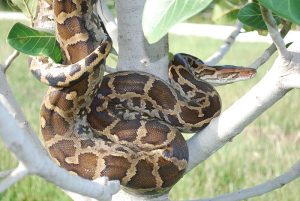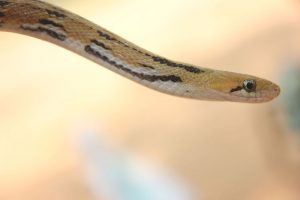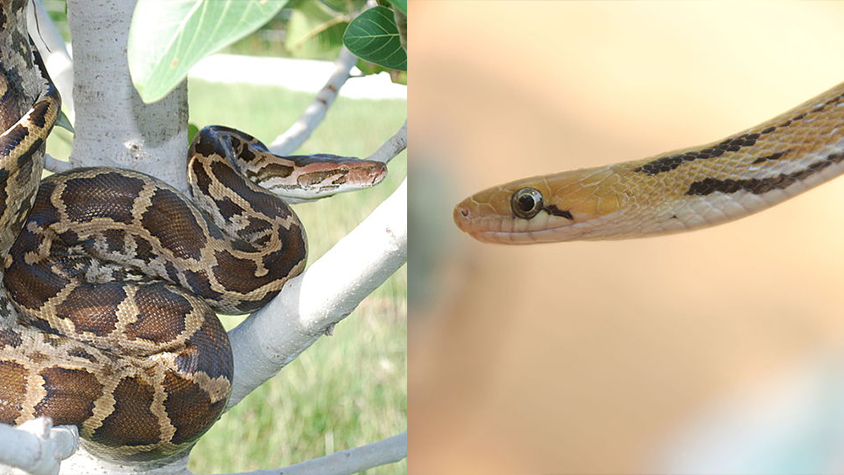Wildlife rescue team of OIPA India – Maharashtra State, Amma Care Foundation (ACF) and Plant & Animals Welfare Society – Mumbai (PAWS-Mumbai) incessantly answer distress calls of residents in Mumbai who report the presence of wild animals in residential areas as happened recently for a spectacled cobra trapped in a washroom.
Last week, volunteers had to run in the village of Rambaug, Powai to rescue a 4 feet long Indian Rock Python from the 5th floor window of an apartment, and to Thakur Village in Kandivali for a 3 feet long common trinket snake blocked in a residential complex. “Both snakes were taken to a veterinarian for a health check and later after informing the forest department of Mumbai, they were relocated back into their natural habitat” said Sunish Subramanian Kunju – Representative for Wildlife Protection & Conservation at OIPA Maharashtra – India and Founder of ACF & PAWS-Mumbai.
 The Indian rock python (Python molurus), also known as black-tailed python, Indian python, or Asian rock python, is a large python species native to tropical and subtropical regions of the Indian subcontinent and Southeast Asia. Like all pythons, it is nonvenomous. The rock python’s color pattern is whitish or yellowish with the blotched patterns varying from tan to dark brown shades according with terrain and habitat. Female rock pythons grow significantly larger than males, reaching lengths of almost 5 m, while, males get to a maximum of 3 m. This snake is classified as Near Threatened on the IUCN Red List due to a likely population decline of approx. 30% over the decade 2010-2020 caused by habitat loss, over-exploitation, and lack of conservation actions.
The Indian rock python (Python molurus), also known as black-tailed python, Indian python, or Asian rock python, is a large python species native to tropical and subtropical regions of the Indian subcontinent and Southeast Asia. Like all pythons, it is nonvenomous. The rock python’s color pattern is whitish or yellowish with the blotched patterns varying from tan to dark brown shades according with terrain and habitat. Female rock pythons grow significantly larger than males, reaching lengths of almost 5 m, while, males get to a maximum of 3 m. This snake is classified as Near Threatened on the IUCN Red List due to a likely population decline of approx. 30% over the decade 2010-2020 caused by habitat loss, over-exploitation, and lack of conservation actions.
 The common trinket snake (Coelognathus helena) is a nonvenomous constrictor species of colubrid snake native to south Central Asia. Adults are darker brown, with a transverse series of squarish black spots, or with more or less distinct traces of the color pattern of the young. There is a vertical black streak below the eye, and an oblique black streak behind the eye. Some specimens have a white, black-edged collar; others have two black longitudinal streaks on the head; and others are intermediate in this respect. The lower parts are yellowish, with or without a few small black spots, sometimes with a more or less distinct festooned marking on each side. Adults may attain a total length of 4.5 ft (1.4 m).
The common trinket snake (Coelognathus helena) is a nonvenomous constrictor species of colubrid snake native to south Central Asia. Adults are darker brown, with a transverse series of squarish black spots, or with more or less distinct traces of the color pattern of the young. There is a vertical black streak below the eye, and an oblique black streak behind the eye. Some specimens have a white, black-edged collar; others have two black longitudinal streaks on the head; and others are intermediate in this respect. The lower parts are yellowish, with or without a few small black spots, sometimes with a more or less distinct festooned marking on each side. Adults may attain a total length of 4.5 ft (1.4 m).
Thanks to all the people involved: volunteers, Range Forest Officer and Round Officer of Mumbai; veterinarians and last but not least the team of OIPA, ACF and PAWS-Mumbai.








